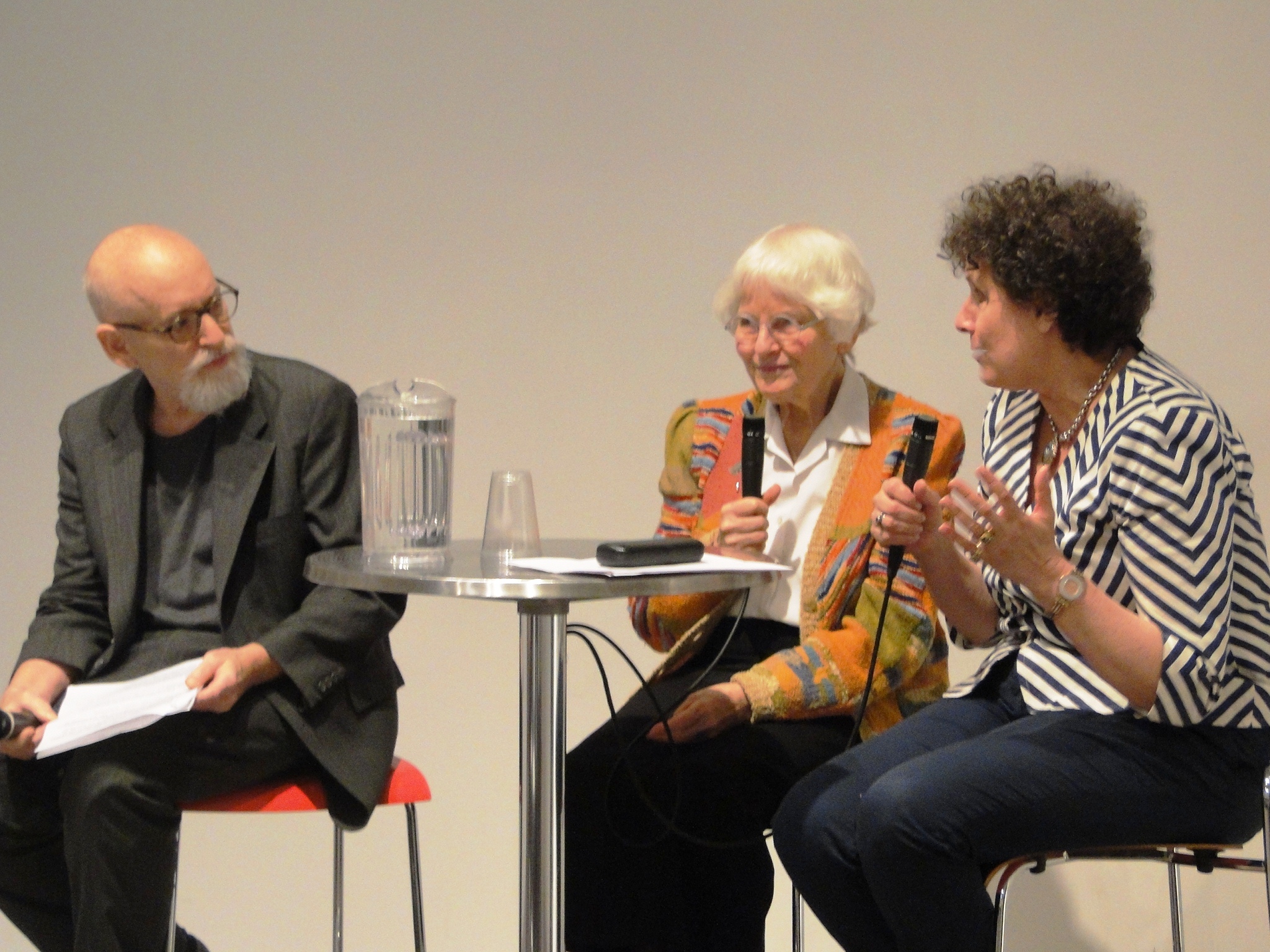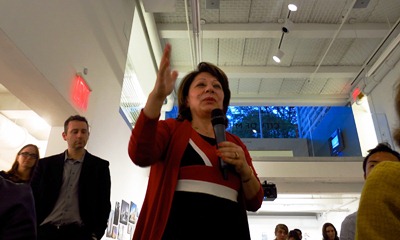by admin

(l-r) Frederic Schwartz, FAIA, Denise Scott Brown, RIBA, Int’l. FRIBA, and Renata Holod.
Laura Trimble

Dr. Ghada Musa Rzouki Al-Slik updates the panel and audience on the Mosque competition.
Benjamin Kracauer
Event: The National Mosque of Baghdad Competition: A Conversation between Denise Scott Brown, Renata Holod, and Frederic Schwartz
Location: Center for Architecture, 05.04.2012
Speakers: Denise Scott Brown, RIBA, Int’l. FRIBA, Principal, Venturi, Scott Brown and Associates; Renata Holod, Ph.D., Professor, Islamic Art and Architecture, University of Pennsylvania; Frederic Schwartz, FAIA, Principal, Frederic Schwartz Architects
Introduction/Moderator: Cynthia Kracauer, AIA, LEED AP, Managing Director, Center for Architecture
Organizers: Center for Architecture; a program of the exhibitions “Change: Architecture and Engineering in the Middle East, 2000-Present” and “City of Mirages: Baghdad, 1952-1982″
Sponsors: A. Estéban and Co. (benefactor); Buro Happold (lead sponsor); Eytan Kaufman Design and Development, FXFOWLE (sponsors); Arup, Columbia University Graduate School of Architecture, Planning, and Preservation, Dewan Architects & Engineers, GAD, HDR, Kohn Pedersen Fox Associates, NAGA Architects, Ramla Benaissa Architects, RBSD Architects, Skidmore, Owings & Merrill, World Monuments Fund, Zardman (supporters)
Architects worldwide have long debated the risks, potential value, and ethics of accepting work from objectionable governments. Allowing for a range of opinion on which compromises make a commission acceptable or unacceptable, two points in favor of such projects arose in this discussion about a difficult decision and a complex, fascinating project, the National Mosque of Baghdad, unbuilt but influential. One important consideration is that architecture can outlast governments (especially dictatorships); in the long run, one designs and builds for communities, nations, and cultures, not regimes. The other is the “first three rules of architecture” promulgated by Henry Hobson Richardson (though the line is sometimes attributed to Frank Lloyd Wright): “get the job, get the job, get the job.”
During the 1982 invited competition to design the National Mosque of Baghdad while Saddam Hussein was in power, Venturi, Rauch, and Scott Brown (now Venturi, Scott Brown and Associates, VSBA) consulted with the State Department about the advisability of the project, reported Denise Scott Brown, RIBA, Int’l. FRIBA. Skeptical about working with the Iraqi state but drawn to the adventure, she was surprised to learn of a temporary policy tilt toward Saddam during the Reagan administration and the Iran-Iraq war, clearing the way for VSBA to accept its selection. Difficulties included her own inability to visit the site (being Jewish, she faced risks in Baghdad that did not affect other firm members), and an acute awareness of how badly the regime had treated Iraqi architects – even the diplomatic and globally-minded Rifat Chidirji, whom it had imprisoned, then released into a position of tightly circumscribed professional authority with orders to beautify Baghdad for a conference of nonaligned nations. The project yielded unique insights into what design can and cannot accomplish in a repressive society. “When you work in architecture, you can remove the barriers, but you can’t make people do things,” Scott Brown commented. “I’m not about to do regime change through a building – that’s delusions of grandeur.”
Had Saddam’s mosque been built, it would have been the largest in the Middle East. The program called for a scale that could hold more than 30,000 worshipers (both in stationary prayer and in mass processions), a non-hierarchical layout, and references to monuments in the Arab world reaching from Cordoba to Samarra, while avoiding features derived from Ottoman culture, since Iraq had chafed under Ottoman rule, or from Shi’a Islam (the Iraqi rulers were Sunni). VSBA’s design, displayed as a model in the Center for Architecture’s “City of Mirages” exhibition, modernizes the traditional Arab hypostyle form, aided by contemporary engineering in the form of trusses over 70 meters long, and includes a front-and-center decorative structure known as a muqarnas, a series of rotating niches mathematically tiled and ending in a small upper dome (it is not set back as a central dome, a feature associated with Ottoman design). Color and signage, with Kufic calligraphic characters the height of a human being arrayed in a distinct blue external band, establish linkages between precedents like the Cordoba mosque and the legible exteriors familiar from other VSBA projects. This design is a decorated shed on a vast scale, commented ex-VSBA staffer Frederic Schwartz, FAIA, who is now a principal of his own firm, Frederic Schwartz Architects.
Renata Holod, a cultural advisor to VSBA for the project, observed that state mosques are a recent typology, associated with postcolonial conditions in which “all these states around the Gulf became history-minded.” While study of historical contexts was essential, in many respects the firm was inventing procedures and working without a net. VSBA assembled a diverse team of consultants, translators, and scholars for the project; it was the professional opportunity of a lifetime, all speakers recalled, to solve the challenges of accommodating communal prayer on such a scale, from gender separation to bus access, while negotiating the pressures and risks presented by the Ba’athist state. Stephen Izenour in particular, Scott Brown recalled, “was fearless,” even at one meeting reportedly attended by Saddam: “At one point Steve said something and a member of the ruling party stood and said, ‘I do not want to hear any of the Iraqi architects repeating that.’ And Steve looked around, and saw all the Iraqi architects had turned white.”
A dramatic moment occurred at the end of the audience questioning period, after discussions of problems presented by a worldwide range of clients and customs. Ghada Musa Rzouki Al-Slik, Ph.D., an Iraqi architect and professor at the University of Baghdad, who was present at the original presentation in 1982, contributed a firsthand update to give the story a degree of closure. After officials scuttled plans to build the VSBA mosque, the competition was repeated in 1989 for a new site, limited this time to Iraqi and Arab firms, with cancelation and reactivation alternating during successive conflicts. War with the U.S. from 2003 to the end of his regime meant that from the chosen design, only a few columns were ever built.
Saddam did build a different garish mosque on one-fifth the scale of the Great Mosque, named Umm al-Ma’arik, “Mother of Battles” (now Umm al-Qura, “Mother of Cities”). At the original site, an international competition is currently considering designs for Iraq’s future parliament building, using the columns intended for the Great Mosque – a step toward repurposing ruins of a structure once meant to glorify a dictator, now to shelter a fragile democratic institution.
Bill Millard is a freelance writer and editor whose work has appeared in Oculus, Icon, Content, The Architect’s Newspaper, and other publications.

